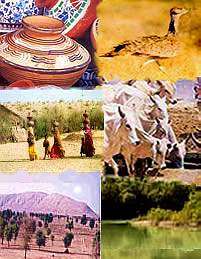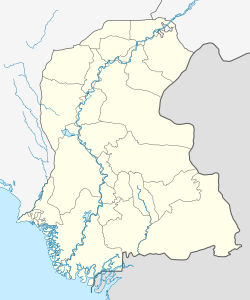Tando Allahyar facts for kids
Quick facts for kids
Tando Allahyar
|
|
|---|---|

Tando Allahyar
ٽنڊو الهيار |
|
| Country | |
| Province | |
| Division | Hyderabad |
| District | Tando Allahyar |
| Population
(2023 census)
|
|
| • City | 171,185 |
| • Rank | 56th, Pakistan |
| Time zone | UTC+5 (PST) |
Tando Allahyar (Sindhi: ٽنڊوالهيار, Urdu: ٹنڈو الہ یار) is a city in Sindh, Pakistan. It is the main city and capital of the Tando Allahyar District. This means it is the most important city in its area. Tando Allahyar is one of the largest cities in Pakistan. In 2017, it was the 56th biggest city by population.
Contents
Exploring the History of Tando Allahyar
Tando Allahyar was started a long time ago. It began during the time of the Talpur rulers. When Bachal Yousfani was the mayor, he helped the city grow. He built places for people to stay and new homes. He also helped create jobs for the people living there.
The Fort Built in 1709
Tando Allahyar was founded in 1709. A ruler named Talpur built a fort. This fort was made of mud and clay. It was about 3 kilometers (1.8 miles) from where the city center is today. The fort was built to keep Mir Talpur and the local people safe. It was also a place where people could trade goods. As the town grew around the fort, it was called "Allahyar Jo Tando." This means "Allahyar's Town." Today, this old fort is known as "Kacho Qilo." Some of its original decorated walls can still be seen.
How British Rule Changed the City
In 1906, when the British ruled the area, a railway station was built. This showed that Tando Allahyar was becoming an important place. It was a center for farming and trade. The town's name changed from "Allahyar Jo Tando" to "Tando Allahyar." The British government then used the old fort for their own purposes.
The Importance of the Canal
In 1933, a canal was built in Tando Allahyar. This canal helped the city become even more important for farming and trade. It brought water to the fields, which helped crops grow better.
Tando Allahyar After Pakistan's Independence
Before 1947, most people in Tando Allahyar were Hindu. The temple of Baba Ramdevji Rama-Pir was a special place. It showed how Hindus and Muslims lived together peacefully. After Pakistan became independent in 1947, many Hindu followers moved away. However, the temple is still in the city center. It is a popular place for Hindu visitors.
Most of the Muslim people in the area supported the idea of Pakistan. After Pakistan became independent in 1947, many Hindu and Sikh people moved to India. At the same time, Muslim families who had to leave India came to live in the Tando Allahyar District.
Ramapir Temple: A Place of Worship
The Rama Pir Mandir is a famous temple in Tando Allahyar. It is dedicated to Ramdev Pir. This temple is the second largest pilgrimage site for Hindus in Pakistan. Every year, a three-day festival (Mela) is held here. This festival takes place in the Hindu month of Bhadrapada.
Where is Tando Allahyar Located?
Tando Allahyar is about 40 kilometers (25 miles) northeast of Hyderabad. It is on the road that connects Hyderabad and Mirpurkhas. Tando Allahyar is also a key railway center for the Sindh region.
| Nearby large cities | Distance | |
|---|---|---|
| km | mi | |
| Hyderabad | 42 | 26 |
| Mirpurkhas | 35 | 22 |
| Karachi | 210 | 130 |
| Larkana | 330 | 210 |
| Sukkur | 360 | 220 |
| Pano Aqil | 400 | 250 |
Understanding the People of Tando Allahyar
How Many People Live Here?
As of 2010, about 400,000 people lived in Tando Allahyar and its nearby areas. About 30% of the people are Muslims who moved from India after Pakistan became independent in 1947. The other 70% are people who have lived in Sindh for a long time. Many people in Tando Allahyar speak Urdu, Baloch, Punjabi, and Pashto.
Hindu Temples in the City
- Shri Ramapir
- Rama Pir
What is the Climate Like?
Tando Allahyar is hot for most of the year. However, the nights often have cool breezes, which makes them more comfortable.
| Climate data for Tando Allahyar | |||||||||||||
|---|---|---|---|---|---|---|---|---|---|---|---|---|---|
| Month | Jan | Feb | Mar | Apr | May | Jun | Jul | Aug | Sep | Oct | Nov | Dec | Year |
| Mean daily maximum °F (°C) | 77 (25) |
79 (26) |
84 (29) |
90 (32) |
111 (44) |
111 (44) |
91 (33) |
88 (31) |
88 (31) |
91 (33) |
88 (31) |
81 (27) |
90 (32) |
| Mean daily minimum °F (°C) | 55 (13) |
57 (14) |
66 (19) |
73 (23) |
79 (26) |
82 (28) |
81 (27) |
79 (26) |
77 (25) |
72 (22) |
64 (18) |
59 (15) |
70 (21) |
Farming and Economy
Tando Allahyar is one of the richest farming areas in Pakistan. Important crops like sugarcane, wheat, onion, and cotton are grown here. Delicious Mangoes and bananas are also farmed. The city has sugar mills and factories that process cotton.
Mohsin Rasheed Memon Mango Farm is a large mango farm. It is located about 3 kilometers (1.8 miles) from the city center. This farm grows many types of mangoes, including Sindhri, Dashari, Langra, Anwer Ratol, Siroli, and Patasha.
Religion in Tando Allahyar
Most people in Tando Allahyar are Muslim, belonging to either the Shia or Sunni branches of Islam. There is also a small Hindu community in the city. These Hindu families mostly work in business. In the countryside, Hindu communities are often involved in farming. The city has some special religious places called shrines. There is also a very old religious school (madrasa) called Darul Uloom, which was once known as "Saniye Darul Uloom."
Culture and Traditions
Tando Allahyar has a rich and traditional Sindhi culture. Women often wear a Shalwar Kameez. They also wear a traditional dress called the gharara or "parro." It is common for women to wear many bangles on their arms. Men wear a Shalwar Kameez with wider bottoms. They also wear a traditional Sindhi-style cap. Young people might also wear Western clothes.
Languages Spoken
The main languages spoken in Tando Allahyar are Sindhi, Siraiki, and Urdu. Other languages spoken include Rajisthani Qaimkhani Khanzada, Dhatki, Marwari, Balochi, Punjabi, and Brahui. Some Dravidian languages are also spoken.
City Architecture
Tando Allahyar is a busy town with streets lined with mango trees. Many old buildings have special chimney-like structures on their roofs. These are used to catch the breeze and help cool the buildings inside.
Education in Tando Allahyar
More people in the city areas of Tando Allahyar can read and write compared to those in the countryside.
The government helps by building schools and providing teachers. However, teachers often receive little training. They tend to teach in an older, more strict way. Education in Tando Allahyar is usually in Urdu. This is because most students are familiar with the Urdu language.
Images for kids
See also
 In Spanish: Tando Allahyar para niños
In Spanish: Tando Allahyar para niños



